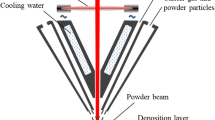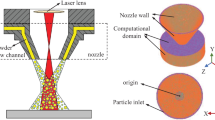Abstract
In the metal deposition process, the performance of the nozzle is crucial to the quality of clad. Continuous coaxial nozzles are broadly used in this process for repairing two- and three-dimensional parts, because it can create a homogeneous distribution of powder particles. In addition, an inert gas can be applied using this type of nozzles which shields powder particles and laser interaction zone, and prevents the surface from oxidizing at high process temperatures. However, when this type of nozzle is tilted from the vertical axis for cladding non-horizontal surfaces, the effect of gravity on powder particles affects the uniformity of powder distribution at the nozzle outlet. This matter limits the application of the nozzle at non-zero inclination angles in multi-axis cladding. The purpose of this paper is to present a new design for continuous coaxial nozzles which is less sensitive to gravity, and thus, improves the performance of the nozzle at non-zero inclination angles. The new design is based on changing the configuration of nozzle inlets and partitioning powder flow in existing continuous coaxial nozzles. The powder flow is divided into eight parts before entering the nozzle, each part passing through one of the eight radially symmetrical grooves embedded in the inner cone of the nozzle. The performance of the new design is investigated through numerical simulation of powder flow in the nozzle. Improved values for the parameters affecting the powder flow distribution, including the velocity of carrier gas and the geometric dimensions of powder inlet and outlet sections, is also extracted. The simulation results show that using the new design, the deviation of the powder focal point from the nozzle axis is decreased. It is observed that at inclination angles of 0, 20, 30 and 45 degrees, the powder passing through a circle of 2.5 mm diameter is 90%, 89%, 87% and 86%, respectively. This indicates that tilting the nozzle has a small influence on the amount of powder delivered at the nozzle focal plane. Consequently, by reducing the effect of gravity on the powder flow distribution, the new nozzle can be used in a wide range of inclination angles.
















Similar content being viewed by others
References
Toyserkani E, Khajepour A, Corbin S (2004) Laser cladding. 119.
Fujishima M, Govekar E, Levy G (2017) Head for additive processing, processing machine, and processing method. WO 2017/115406 A1.
Singh A, Kapil S, Das M (2020) A comprehensive review of the methods and mechanisms for powder feedstock handling in directed energy deposition. Addit Manuf 35:101388. https://doi.org/10.1016/j.addma.2020.101388
Kürnsteiner P, Wilms MB, Weisheit A, Barriobero-Vila P, Gault B, Jägle EA et al (2017) In-process precipitation during laser additive manufacturing investigated by atom probe tomography. Microsc Microanal 23:694–695. https://doi.org/10.1017/S1431927617004135
Hao J, Meng Q, Li C, Li Z, Wu D (2019) Effects of tilt angle between laser nozzle and substrate on bead morphology in multi-axis laser cladding. J Manuf Process 43:311–322. https://doi.org/10.1016/j.jmapro.2019.04.025
Li X, Li T, Shi B, Wang D, Adnan M, Lu H (2020) The influence of substrate tilt angle on the morphology of laser cladding layer. Surf Coat Technol 15:7
He Y, Wei J, Liu J, Wang X, Wang Y, He L (2020) Experimental study on the fabrication profile and mechanical properties by substrate-inclined angle using laser melting deposition (LMD) integrating with the substrate of stainless steel. Optics Laser Technol. https://doi.org/10.1016/j.optlastec.2019.106038
Ferreira E, Dal M, Colin C, Marion G, Gorny C, Courapied D et al (2020) Experimental and numerical analysis of gas/powder flow for different LMD nozzles. Metals 10(15):1–20
Li Y, Gu D, Shi X, Dai D, Ge Q, Sun Y (2021) Influence of environmental constraints and carrier gas velocity on powder concentration and temperature distribution during laser inside additive manufacturing process. CIRP J Manuf Sci Technol 32:70–80
Doubenskaia M, Kulish A, Sova A, Petrovskiy P, Smurov I (2021) Experimental and numerical study of gas-powder flux in coaxial laser cladding nozzles of Precitec. Surf Coat Technol 406:126672
Zhang J, Yang L, Zhang W, Qiu J, Xiao H, Liu Y (2020) Numerical simulation and experimental study for aerodynamic characteristics and powder transport behavior of novel nozzle. Opt Lasers Eng 126:105873. https://doi.org/10.1016/j.optlaseng.2019.105873
Guo W (2007) Compact coaxial nozzle for laser cladding. US Patent 7,259,353 B2. https://www.google.ch/patents/US7259353
Sato A, Ishikawa Y, Nowotny S, Scharek S (2009) Powder metal cladding nozzle. US Patent 7,626,136 B2. http://www.google.ch/patents/US7626136
Whitfield RP, River B (2012) Laser cladding device with an improved nozzle. US Patent 8,117,985 B2. https://www.google.com/patents/US8117985
Arrizubieta JL, Tabernero I, Exequiel Ruiz J, Lamikiz A, Martinez S, Ukar E (2014) Continuous coaxial nozzle design for LMD based on numerical simulation. Phys Proc 56:429–438. https://doi.org/10.1016/j.phpro.2014.08.146
Liu Z, Qi H, Jiang L (2016) Control of crystal orientation and continuous growth through inclination of coaxial nozzle in laser powder deposition of single-crystal superalloy. J Mater Process Technol 230:177–186
Zekovic S, Dwivedi R (2007) Numerical simulation and experimental investigation of gas – powder flow from radially symmetrical nozzles in laser-based direct metal deposition. Internat J Machine Tools Manuf 47:112–123. https://doi.org/10.1016/j.ijmachtools.2006.02.004
Kovalev OB, Bedenko DV, Zaitsev AV (2018) Development and application of laser cladding modeling technique: from coaxial powder feeding to surface deposition and bead formation. Appl Math Model 57:339–359. https://doi.org/10.1016/j.apm.2017.09.043
Author information
Authors and Affiliations
Corresponding author
Ethics declarations
Conflict of interest
On behalf of all authors, the corresponding author states that there is no conflict of interest.
Rights and permissions
About this article
Cite this article
Nasiri, M.T., Movahhedy, M.R. A new design of continuous coaxial nozzle for direct metal deposition process to overcome the gravity effect. Prog Addit Manuf 7, 173–186 (2022). https://doi.org/10.1007/s40964-021-00223-0
Received:
Accepted:
Published:
Issue Date:
DOI: https://doi.org/10.1007/s40964-021-00223-0




